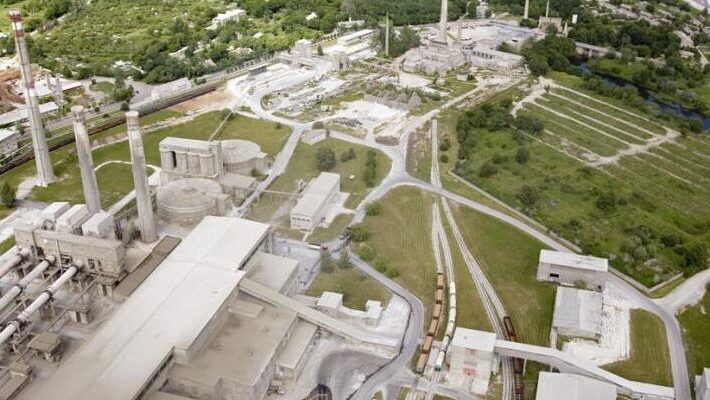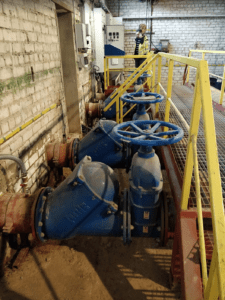- 15%saved from monthly energy bill
- 120tof CO2 emissions reduced annually
- 21MWhmaximum automated flexibility
- 0%of core business affected
About Kunda Nordic Tsement
AS Kunda Nordic Tsement is a company founded in 1992, which is 75% owned by the HeidelbergCement Group and 25% by the Irish group CRH, both of which are leading manufacturers of construction materials in the world. The company has two strategic directions – cement production and gravel production.
Kunda Nordic Tsement has a great location on the coast of the Gulf of Finland. The company owns three quarries: Estonia’s largest Aru-Lõuna limestone quarry (over 400 ha), located 8 km from the plant; Ubja oil shale quarry and clay quarry Mereäärne. In addition to 5 cement types, the product portfolio includes more than 15 fractions of limestone crushed stone and more than 20 fractions of granite crushed stone. In addition, the company offers lime fertilizer for agricultural fields.
Market situation
Since the establishment of the company, cement production in Estonia has been related to exports – it is not possible to produce cement efficiently only for the small Estonian market. Because of that you can find building made from Kunda’s cement in Latvia, Lithuania, Finland, Sweden, and Russia. The most distant destinations to which semi-finished cement clinker has been delivered are West Africa and Brazil.
However, the company’s first and most important task has always been to secure the home market with high-quality cement. Today, the focus is more on the domestic market as the dominant cement company with a comprehensive product portfolio.
The construction market is currently very active. However, it is not clear what the impact on the market the rising of energy and material prices and availability together with the general inflation will bring in the near future.
Challenges
Due to the rising prices of CO2 emission allowances and the old and energy-intensive production technology used in the plant, the HeidelbergCement Group decided to stop producing clinker at the Kunda plant. From 2020, clinker will be brought to Kunda from the Group’s Slite plant in Sweden. Due to the more modern production process, it is possible to produce raw materials with a lower carbon footprint, and HeidelbergCement and the Slite plant have the ambition to reach the production of carbon-neutral concrete by 2030. This means that concrete produced from ground cement at the Kunda plant will also be carbon neutral in the future.
At the same time, the company is facing the arrival of cheap cement from Belarus because there is no C02 quota system and fuel and energy prices are cheaper.
In Estonia, however, energy prices have risen sharply recently, which is a real challenge for the competitiveness of an energy-intensive company such as Kunda Nordic Tsement.
Objectives
What we hoped to achieve from the beginning with the Fusebox solutions was to maximize our financial income within the flexibility of electricity consumption by increasing or decreasing electricity consumption compared to our normal levels. The power we have allowed Fusebox to control remotely through demand response or stock market price optimization is the total power of the mill’s quarry water pump, which is 210 kW. This allows us to flexibly use our quarry’s water pump, where in addition to our own water measurement solutions the pump is also controlled remotely by Fusebox software.
Alternatives
Alternatively, we have had a control system based on the Grundfos controller CU362 since 2017, which monitored the groundwater level and activated the pumps accordingly. The system took into account pump operating hours, starts, maintenance intervals, electricity consumption, and monitoring disturbances – in short, a commendable solution that was well monitored and controlled over the web in Grundfos’ own environment. However, Grundfos ran into problems when we tried to integrate third-party web-based remote control with the system. As the protracted multilateral negotiations failed, we decided in favor of Fusebox and replaced the existing management system with a controller.
Technical Solution
Today, there are 4 water pumps in the Kunda Nordic Tsement limestone quarry, which are operated with smooth starters according to the water level. Water level information is collected in the lead controller by means of an analogue sensor and two emergency floats. However, as the change in water level in the quarry is slow, there is usually no need to use more than half of the pumps at the same time, and if necessary, all pumps can be stopped for hours.
Data related to pump control (venous flow, pump states, operating hours, power consumption) are available via both the on-site user interface and the Internet. In addition to venous flow, the exchange price of energy and signals from Fusebox’s virtual power plant are also used to control the pumps. Here the “virtual power plant” means the ability to increase or decrease consumption at the moment when the energy seller is ready to pay for it.
 Neeme Takis
Neeme Takis
Fusebox Head of Technology
With the Fusebox solution, it was possible to use the entire capacity of the pumping station during the cheapest hours, stopping the operation of the pumping station completely for the most expensive hours. The cheapest hours are found automatically and continuously by the software, monitoring the electricity exchange price. Several hours a day is enough to pump, Fusebox software calculates the water level based on the information.
The biggest savings for KNT come from running the pumps at market price. However, the Fusebox solution also allows the use of the pumping station to be controlled in order to balance the electricity network. By responding to the control signals sent from the Fusebox server on the basis of Elering’s orders, about a third of what is saved by monitoring the stock price is earned.
Results
Fusebox’s solution is in line with both the pumping station’s equipment and the principle that operating the pumping station must be financially profitable. To this effect we have earned 7776€ in the fourth quarter of 2021 by regulating 63.5 MWh of network load. This amounts to 32 tons of CO2.
As the change in water level in a quarry is slow, there is usually no need to use more than half of the pumps at the same time, and if necessary, all pumps can be stopped for hours. Largely, more frequent shutdowns have not affected us, as the required amount of water will be pumped out of the quarry by the end of the month, and the priority of the water level sensor in the software will ensure that the quarry is not flooded remotely. On the other hand, the frequency of pump switching has increased approximately three times, and technical maintenance personnel keep an eye on the cost components of the pumping station.



